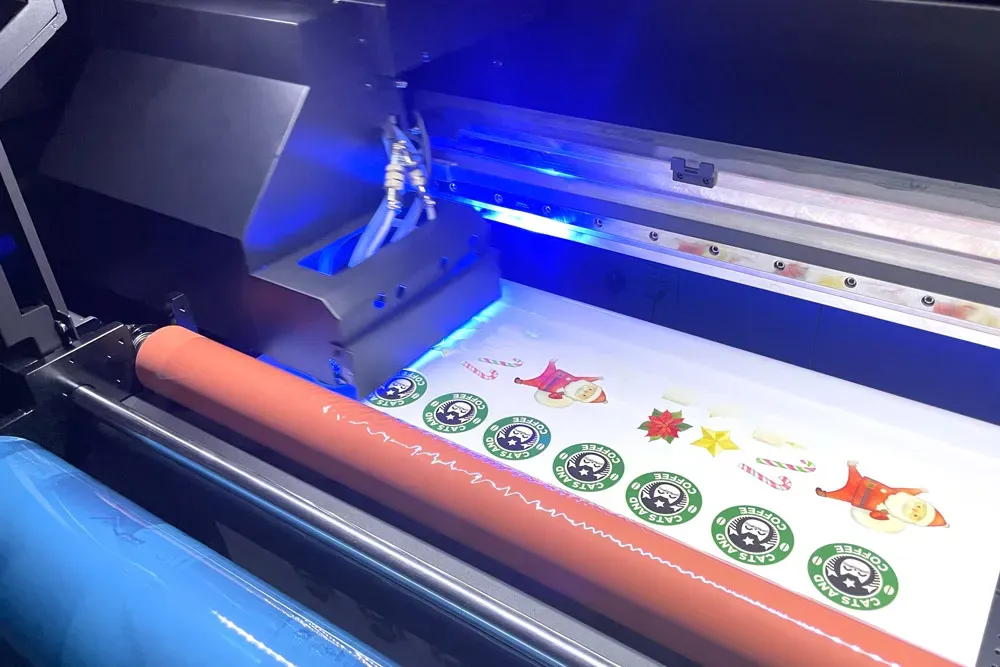UV DTF printing, also known as Ultra Violet Direct-to-Film printing, is revolutionizing the printing industry with its cutting-edge technology. By combining the efficiency of UV printing with the flexibility of direct-to-film techniques, this innovative method enables the creation of vibrant, durable custom prints on various materials including plastics, metals, and fabrics. As sustainability becomes a priority in production processes, UV DTF stands out for its minimal waste and low volatile organic compound (VOC) emissions, aligning with the growing demand for eco-friendly printing innovations. Companies are increasingly gravitating towards this technology to enhance their product offerings and meet customer preferences for tailored designs. In this article, we will delve into the fundamentals of UV DTF printing, exploring market trends, sustainability benefits, and its promising future in the realm of advanced printing technology.
Exploring Ultra Violet Direct-to-Film printing presents a glimpse into the forefront of innovative graphic reproduction methods. This state-of-the-art printing technology offers high-quality outputs and rapid production speeds while harnessing sustainable practices within the industry. Known for creating stunning custom prints, it empowers businesses in a variety of fields, from fashion to promotional products, to elevate their branding with eye-catching designs. This transformative printing solution not only emphasizes efficiency but also champions environmental consciousness with its reduced waste and non-toxic emissions. As we examine the implications of alternative printing technologies, UV DTF emerges as a key player set to redefine the boundaries of what is possible in the world of printing.
Understanding the Basics of UV Direct-to-Film Printing
UV Direct-to-Film (DTF) printing is a revolutionary technique that combines ultraviolet light with traditional direct-to-film methods. This advanced printing technology enhances the production process by rapidly curing inks, allowing for immediate readiness of printed materials. The technique is not only faster but also compensates for common issues seen in traditional methods, such as ink bleeding or long drying times. It is particularly useful for industries requiring high durability and precision, such as custom apparel, promotional products, and high-quality art reproductions.
One of the most appealing aspects of UV DTF printing is its adaptability. The technology allows for high-resolution prints on an array of materials, from plastics to textiles and metal components. This versatility opens up new avenues for creativity and design, enabling businesses to offer unique, customized prints. With an increasing demand for personalization in consumer products, UV DTF technology provides an effective solution that meets the rising expectations of customers seeking distinctive prints.
Advantages of UV DTF Printing Technology
The benefits of UV DTF printing are numerous, positioning it as a preferred choice for modern printing needs. One significant advantage is the speed of the printing process. Thanks to the instantaneous curing capabilities of UV light, prints can be handled almost immediately post-production, drastically reducing lead times for businesses. This enhancement not only increases overall productivity but also allows for efficient order fulfillment, a crucial aspect in competitive markets.
Another standout feature of UV DTF technology is the quality of the printed images. Inks used in this process exhibit superior adhesion and durability, resulting in vibrant colors that resist fading and scratching. The cured finish is often smoother than that achieved by traditional printing methods, which elevates the final product’s overall aesthetic quality. As brands strive for excellence in product presentation, the UV DTF printing method offers substantial benefits in quality and reliability.
Market Trends in UV DTF Printing Adoption
The market for UV DTF printing technology is growing rapidly as more industries recognize its potential for customization and efficiency. Sectors such as fashion, advertising, and promotional goods are leading the charge, leveraging the technology to create bespoke products that cater to specific customer desires. The trend towards personalized products strengthens consumer engagement, encouraging brands to invest in UV DTF printing to stand out in crowded marketplaces.
Additionally, the rise of e-commerce has further fueled demand for customizable solutions. As businesses adapt to online retail environments, the need for high-quality, unique products becomes critical. UV DTF printing offers brands the ability to provide customers with customized options that can be produced quickly and efficiently. This shift towards personalization not only enhances customer satisfaction but also reinforces brand loyalty in a competitive landscape.
Sustainability in UV DTF Printing
With sustainability becoming a central focus across industries, UV DTF printing technology aligns perfectly with eco-friendly principles. This printing method generates significantly less waste compared to traditional techniques, making it a more viable option for companies striving to reduce their environmental impact. The ability to produce high-quality prints with minimal ink waste translates into both cost savings and enhanced ecological responsibility.
Furthermore, UV DTF inks have low volatile organic compound (VOC) emissions, promoting better air quality, especially in indoor environments. This aspect is increasingly relevant as businesses face greater scrutiny regarding their environmental practices. By adopting UV DTF printing technology, companies not only improve their manufacturing processes but also showcase their commitment to sustainability, which resonates positively with environmentally-conscious consumers.
Challenges Faced by UV DTF Printing Businesses
Despite its advantages, the adoption of UV DTF printing does come with its challenges. One of the primary barriers is the initial investment required for the equipment. High-quality UV DTF printers can represent a significant expense, which may deter smaller businesses or startups from adopting this innovative technology. However, as the demand increases and technology becomes more mainstream, prices are expected to decrease, allowing broader access to this printing solution.
Additionally, there is a learning curve associated with transitioning to UV DTF technology. Existing staff may require training to efficiently handle new printing processes and machinery. Companies must be prepared to invest time and resources into this learning phase, which may temporarily affect productivity. Nevertheless, with appropriate training and adapted workflows, the long-term benefits of increased efficiency and quality can outweigh these initial challenges.
The Future Outlook of UV DTF Printing Technology
Looking ahead, the future of UV DTF printing appears bright as industries continue to pursue innovative solutions for their printing needs. As the technology evolves, we can expect enhancements in speed, quality, and functionality, which will further solidify UV DTF’s position as a leading choice in the printing market. Advances in ink formulations and printer capabilities are likely to expand the range of materials and applications suited for this technology.
Companies adopting UV DTF printing can anticipate gaining a competitive edge by delivering high-quality, customizable products that meet the diverse demands of modern consumers. With its sustainable attributes, this technology is also well-positioned to comply with increasing environmental regulations and consumer expectations for eco-friendly practices. As businesses capitalize on these opportunities, UV DTF printing is poised to play a pivotal role in shaping the future landscape of the printing industry.
Frequently Asked Questions
What are the benefits of UV DTF printing technology?
UV DTF printing technology offers numerous benefits, including faster production speeds due to instant ink curing with UV light, exceptional print quality with vibrant colors, durable outputs that resist scratching and fading, and reduced environmental impact through low VOC emissions and minimized waste.
How does UV DTF printing differ from traditional printing methods?
Unlike traditional printing methods, UV DTF printing utilizes UV light to cure inks instantly during the printing process. This innovation allows for precise details, quick turnaround times, and the ability to print on a variety of materials, including plastics, metals, and fabrics, without lengthy drying times.
Is UV DTF printing a sustainable printing option?
Yes, UV DTF printing is considered a sustainable printing option. It significantly reduces ink waste compared to conventional printing and produces low volatile organic compound (VOC) emissions, making it a healthier choice for indoor environments while also lowering the ecological footprint of printing operations.
What materials can be printed using UV DTF printing technology?
UV DTF printing technology is versatile and can print on a wide range of materials including plastic, metal, wood, fabric, and glass. This capability makes it suitable for a variety of applications such as apparel, promotional products, and custom print jobs.
What challenges might businesses face when adopting UV DTF printing?
Businesses may face challenges such as the high initial investment costs for UV DTF printing equipment and a potential learning curve for staff transitioning to this new technology. However, manufacturers typically provide training and resources to assist in the adaptation process.
Can UV DTF printing support customization in printing projects?
Absolutely! UV DTF printing excels in supporting customization opportunities. Its high detail capacity allows for intricate designs and complex graphics, making it an ideal choice for businesses looking to create unique, personalized prints that enhance brand identity.
| Key Point | Description |
|---|---|
| UV DTF Technology | Combines UV light technology with direct-to-film printing, providing faster curing processes. |
| Print Speed | Instantaneous curing allows for quick handling and reduces production times. |
| Ink Quality | Inks are vibrant, durable, and less likely to scratch or fade, resulting in superior print quality. |
| Market Adoption | Increasing acceptance in sectors like apparel and advertising due to customization and cost-effectiveness. |
| Sustainability | Reduced ink waste and low VOC emissions make it an environmentally friendly option. |
| Challenges | Higher initial equipment costs and potential learning curves for staff. |
Summary
UV DTF printing is revolutionizing the printing industry by combining cutting-edge technologies to create a more efficient and sustainable printing solution. By utilizing ultra-violet light to rapidly cure inks, this innovative method not only enhances print quality and speed but also addresses the pressing demand for environmentally friendly practices in the industry. With its versatility across various materials and the growing trend towards customization, UV DTF printing stands at the forefront of modern printing technologies. As businesses increasingly seek solutions that align with consumer preferences and eco-friendly standards, embracing UV DTF printing is likely to unlock new opportunities for growth and competitiveness.



